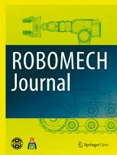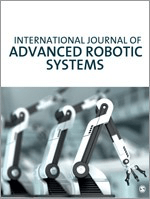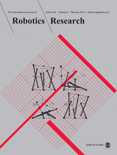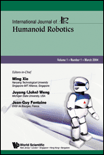
Journal of Micro-Bio Robotics
Scope & Guideline
Exploring the Future of Robotics and Biology
Introduction
Aims and Scopes
- Micro-Bio Robotics Design and Applications:
Research that explores the design principles and real-world applications of micro and bio-robots, particularly in medical and biological contexts. - Actuation and Control Mechanisms:
Investigation into various actuation methods for microrobots, including magnetic, thermal, and acoustic systems, emphasizing precision control and adaptability. - Microfluidics and Sensing Technologies:
Studies focusing on the integration of microrobots with microfluidic systems for applications such as drug delivery, biological manipulation, and environmental monitoring. - Robotic Manipulation and Micromanipulation:
Research on the techniques and systems used for manipulating small objects or biological samples, including the development of novel gripping and sorting mechanisms. - Modeling and Simulation:
Development of predictive models and simulations to understand the behavior of micro-bio robotic systems, which aids in the design and optimization of these systems.
Trending and Emerging
- Integrated Systems for Biomedical Applications:
There is an increasing trend towards developing integrated robotic systems that can perform complex tasks in biomedical applications, such as targeted drug delivery and real-time biological monitoring. - AI and Machine Learning in Robotics:
Recent publications show a growing incorporation of AI and machine learning techniques in microrobotics, enhancing the capabilities of robots to adapt and learn from their environments. - Environmental and Bio-inspired Robotics:
Research focusing on bio-inspired designs and environmentally responsive robotic systems is gaining traction, emphasizing sustainability and efficiency in microrobotic applications. - Advanced Sensing and Imaging Techniques:
Emerging interest in incorporating advanced sensing and imaging technologies, such as optical trapping and deep learning, into microrobotic systems is becoming increasingly prominent, enabling enhanced functionality and precision. - Swarm Robotics:
The exploration of swarm robotic systems, where multiple microrobots work collaboratively, is trending, indicating a shift towards collective behavior and coordination in micro-scale robotics.
Declining or Waning
- Traditional Microrobotics:
Research focused on basic microrobotic systems and their fundamental mechanics has decreased, possibly due to the advancement of more complex and integrated systems. - Static Robotic Systems:
The emphasis on stationary or minimally mobile robotic systems has waned, as newer papers highlight dynamic and mobile systems that can operate in more varied environments. - Single-Function Microrobots:
The development of microrobots designed for singular tasks has seen a reduction, with a growing preference for multifunctional systems that can perform diverse operations.
Similar Journals

ROBOMECH Journal
Fostering Collaboration and Knowledge Sharing in RoboticsROBOMECH Journal, published by SpringerNature, is a prominent open-access journal dedicated to the fields of robotics, mechanical engineering, and artificial intelligence. Established in 2014, the journal has quickly established itself as a vital platform for disseminating innovative research in control and optimization, instrumentation, and modeling and simulation, earning a commendable Q2 ranking in Mechanical Engineering and multiple Q3 rankings across other relevant fields in 2023. With a commitment to facilitating accessible knowledge sharing, ROBOMECH Journal promotes cutting-edge research that drives advancements in both theoretical frameworks and practical applications within the robotics community. Scholars, engineers, and professionals seeking to contribute to or stay informed about the latest developments in these dynamic fields will find the journal's rich array of articles invaluable. With its open-access model, all published research is freely available, ensuring wide dissemination and increased visibility for authors, thus fostering collaboration and innovation across disciplines.

International Journal of Advanced Robotic Systems
Connecting Minds to Shape Robotic FrontiersThe International Journal of Advanced Robotic Systems is a premier academic journal, published by SAGE Publications Inc., dedicated to fostering innovation and research in the rapidly evolving field of robotics. With an ISSN of 1729-8814, this Open Access journal has been providing unrestricted access to cutting-edge research since 2004, making it an invaluable resource for researchers, professionals, and students alike. The journal aims to disseminate high-quality, peer-reviewed articles that cover a wide range of topics, including but not limited to robotic systems, automation, artificial intelligence, and sensor technologies. By promoting interdisciplinary collaboration and encouraging novel approaches, the International Journal of Advanced Robotic Systems plays a crucial role in advancing the frontiers of robotics and ensuring its impactful application across various industries. Engaging with this journal not only keeps you at the forefront of the latest developments but also contributes to the global discourse on robotics and its advancements in science and technology.

JOURNAL OF INTELLIGENT & ROBOTIC SYSTEMS
Leading the Charge in Intelligent EngineeringJOURNAL OF INTELLIGENT & ROBOTIC SYSTEMS, published by Springer, is a premier interdisciplinary journal that focuses on the rapidly evolving fields of artificial intelligence, robotics, and their applications across various engineering domains. With an impressive impact factor and ranked in the Q1 and Q2 quartiles of multiple relevant categories—including Electrical and Electronic Engineering, Control and Systems Engineering, and Mechanical Engineering—this journal is essential for researchers, industry professionals, and graduate students seeking to stay at the forefront of innovation in intelligent systems. The journal publishes high-quality research articles, reviews, and technical notes that contribute to advancing theory, practice, and the integration of intelligent robotic systems better suited to meet contemporary challenges. Founded in 1988, and with a robust indexing in Scopus, the journal continues to foster scholarly discourse and serves as a critical resource for those passionate about the future of intelligent technologies, despite not currently providing open access options.

Biomicrofluidics
Advancing the frontier of microfluidics and biotechnology.Biomicrofluidics is a leading academic journal published by AIP Publishing, dedicated to disseminating cutting-edge research in the interface of microfluidics and biotechnology. Established in 2007 and continuing through 2024, this journal serves as a vital resource for researchers and professionals across various fields, including Biomedical Engineering, Colloid and Surface Chemistry, Condensed Matter Physics, and Nanoscience. With impactful insights and innovative methodologies, it maintains a commendable reputation, reflected in its impressive Scopus rankings, such as 24th in Fluid Flow and Transfer Processes and 10th in Colloid and Surface Chemistry. Although not an open-access journal, Biomicrofluidics ensures accessibility to its valuable content through various subscription options, facilitating knowledge sharing in scientific communities. This journal is essential for those at the forefront of microfluidic technologies and applications, offering a platform for exploring novel approaches and driving advancement in biomedical and engineering sciences.

Industrial Robot-The International Journal of Robotics Research and Application
Elevating Standards in Robotics Research and ApplicationIndustrial Robot-The International Journal of Robotics Research and Application is a premier academic journal published by Emerald Group Publishing Ltd in the United Kingdom. Since its inception in 1973, the journal has established itself as a critical resource for the advancement of knowledge in the fields of robotics and automation. With an impressive Q2 ranking across several categories, including Computer Science Applications, Control and Systems Engineering, and Industrial and Manufacturing Engineering, it places itself among the top-tier journals in its domain. The journal aims to disseminate high-quality research that addresses contemporary challenges and innovations in robotics, thereby supporting both academic inquiry and practical applications in industry. Researchers, professionals, and students are encouraged to contribute to its mission, as it remains vital for those seeking to engage with the ever-evolving landscape of robotic technologies.

INTERNATIONAL JOURNAL OF ROBOTICS RESEARCH
Elevating Knowledge in Robotics and EngineeringINTERNATIONAL JOURNAL OF ROBOTICS RESEARCH (ISSN: 0278-3649, E-ISSN: 1741-3176), published by SAGE PUBLICATIONS LTD, is a leading journal in the fields of robotics and engineering. With an impressive impact factor and recognized as a Q1 journal in various categories including Applied Mathematics, Artificial Intelligence, Electrical and Electronic Engineering, Mechanical Engineering, Modeling and Simulation, and Software, it has established itself as an essential resource for researchers and practitioners alike. The journal covers a wide array of topics relevant to the advancing disciplines of robotics, ensuring comprehensive perspectives on both theoretical and practical applications. Notably, it ranks at the top percentile in Scopus rankings across multiple fields, which underscores its significance in the research community. Published continuously since 1982, the journal invites submissions that push the boundaries of robotics research, offering a platform for innovative ideas and solutions that address complex engineering problems. While it operates under a subscription model, its vast reach and reputation make it an invaluable resource for advancing knowledge in robotics.

Journal of Bionic Engineering
Connecting Scholars to Shape the Future of BionicsJournal of Bionic Engineering is a prominent publication in the field of bioengineering, biophysics, and biotechnology, published by Springer Singapore Pte Ltd. Since its inception in 2006, this journal has provided a vital platform for researchers and professionals to disseminate groundbreaking work and innovative approaches in the rapidly evolving realm of bionic systems and biomimetic technologies. With an impact factor that reflects its quality and relevance, it is currently positioned in the Q2 quartile across several key categories, underscoring its substantial influence in academia. The journal is indexed in Scopus, where it ranks competitively in biochemistry, genetics, molecular biology, and chemical engineering, showcasing its appeal to a broad spectrum of scientific disciplines. Although it does not offer open access, it remains a critical resource for those engaged in advanced research and development, fostering connections among scholars, practitioners, and educators dedicated to pushing the boundaries of bionic engineering. As the journal continues to converge from 2006 to 2024, it aims to uphold its mission of promoting interdisciplinary research that contributes to the understanding and application of bionic technologies in solving real-world challenges.

International Journal of Humanoid Robotics
Advancing the Future of RoboticsInternational Journal of Humanoid Robotics, published by World Scientific Publishing Co Pte Ltd, is a leading platform for researchers and practitioners in the fields of artificial intelligence and mechanical engineering. With an ISSN of 0219-8436 and an E-ISSN of 1793-6942, this journal has established itself as a significant resource since its inception in 2004. Spanning various topics from robotic design and control to human-robot interaction, it serves a diverse interdisciplinary audience. The journal’s impressive ranking in the Scopus database, positioned in the third quartile for both categories in 2023, reflects its growing impact in the academic community. Although not open access, the journal provides crucial insights that advance the understanding of humanoid robotics and foster innovative solutions to real-world challenges. Researchers, professionals, and students are encouraged to engage with this essential resource as it continues to shape the future of robotics through rigorous scientific inquiry and scholarly collaboration.

Frontiers in Robotics and AI
Transforming Ideas into Innovations in Robotics and AIFrontiers in Robotics and AI is a leading journal dedicated to the exploration and dissemination of groundbreaking research in the fields of robotics and artificial intelligence. Published by FRONTIERS MEDIA SA in Switzerland, it has established itself as a vital resource for academics, professionals, and students since its inception in 2014. With an impressive Open Access model, the journal ensures that high-quality research is accessible to a global audience, fostering collaboration and innovation. The journal is recognized for its distinguished impact in the academic community, achieving Q2 quartile rankings in both Artificial Intelligence and Computer Science Applications as of 2023. It currently holds a solid position in Scopus rankings, with a rank of #123 out of 350 in Artificial Intelligence and #223 out of 817 in Computer Science Applications, reflecting its robust contribution to these dynamic disciplines. The journal's scope encompasses a wide range of topics, including but not limited to autonomous systems, machine learning, and human-robot interaction, making it an essential platform for innovative ideas and advanced research.

Intelligent Service Robotics
Leading the Charge: Your Gateway to Cutting-edge Robotics ResearchIntelligent Service Robotics, published by SPRINGER HEIDELBERG, is a leading journal that focuses on the transformative intersection of intelligent systems and robotics, establishing itself as a pivotal resource for researchers, professionals, and students in the fields of Artificial Intelligence, Computational Mechanics, and Mechanical Engineering. With an impressive impact factor reflective of its relevance—featuring a 2023 Q1 ranking in Computational Mechanics and Mechanical Engineering, and Q2 in Artificial Intelligence—this journal disseminates high-quality, peer-reviewed research that propels innovation and application in various engineering disciplines. Operating from its headquarters in Heidelberg, Germany, Intelligent Service Robotics aims to foster a dynamic academic community, encouraging open dialogue and collaboration among thought leaders and emerging scholars alike. The journal invites submissions that provide novel insights and solutions in the rapidly evolving landscape of service robotics, ensuring that it remains at the forefront of scientific discourse. With a converged publication timeline from 2008 to 2024 and robust Scopus rankings, the journal is committed to shaping the future of robotic intelligence and its applications.